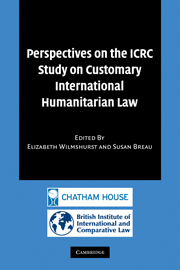Book contents
- Frontmatter
- Contents
- Preface
- List of contributors
- Table of cases
- Table of treaties and other instruments
- Abbreviations
- Part 1 Setting the scene: Theoretical perspectives on international law in the ICRC Study
- Part 2 The status of conflict and combatants: The ICRC Study
- Part 3 Commentary on selected Rules from the ICRC Study
- 6 The law of targeting
- 7 Protected persons and objects
- 8 Natural environment
- 9 Specific methods of warfare
- 10 Weapons, means and methods of warfare
- 11 Fundamental guarantees
- 12 Status and treatment of prisoners of war and other persons deprived of their liberty
- 13 Displacement and displaced persons
- 14 Implementation and compliance
- 15 War crimes
- Part 4 Conclusions
- Index
15 - War crimes
Published online by Cambridge University Press: 09 July 2009
- Frontmatter
- Contents
- Preface
- List of contributors
- Table of cases
- Table of treaties and other instruments
- Abbreviations
- Part 1 Setting the scene: Theoretical perspectives on international law in the ICRC Study
- Part 2 The status of conflict and combatants: The ICRC Study
- Part 3 Commentary on selected Rules from the ICRC Study
- 6 The law of targeting
- 7 Protected persons and objects
- 8 Natural environment
- 9 Specific methods of warfare
- 10 Weapons, means and methods of warfare
- 11 Fundamental guarantees
- 12 Status and treatment of prisoners of war and other persons deprived of their liberty
- 13 Displacement and displaced persons
- 14 Implementation and compliance
- 15 War crimes
- Part 4 Conclusions
- Index
Summary
Introduction
What is a ‘war crime’? Traditional definitions such as ‘violations of the laws of war that incur individual criminal responsibility’ ask more questions than they answer, as the test of individual criminal responsibility has varied down the ages. Whilst it was long understood that domestic courts could deal with ‘crimes of war’ within their jurisdiction, it was only the advent of international criminal justice in the twentieth century that brought the issue back into the public consciousness. The London Charter, at the end of World War II, gave the Nuremberg Tribunal jurisdiction over ‘violations of the laws or customs of war’ and provided an illustrative list, drawn primarily from the Hague Regulations of 1907. This gave considerable discretion to the judges themselves in deciding what fell within their jurisdiction and what did not. The Geneva Conventions of 1949 drew a distinction between ‘grave breaches’ of the Conventions, specified in the text, against which States were required to enact legislation on the basis of obligatory universal jurisdiction, and other acts contrary to the Conventions where States were only required to ‘take measures necessary’ for their suppression. The grave breaches were clearly defined to include the most heinous acts. However, they were committed only in international armed conflict.
It was in effect the Nuremberg definition, with an expanded list of crimes, which was adopted by the International Criminal Tribunal for the Former Yugoslavia.
- Type
- Chapter
- Information
- Publisher: Cambridge University PressPrint publication year: 2007
- 1
- Cited by

